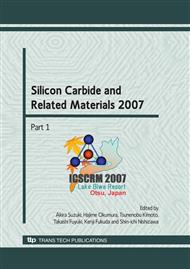p.1007
p.1011
p.1015
p.1019
p.1023
p.1027
p.1031
p.1035
p.1039
Annealing Effect on Characteristics of p+n 4H-SiC Diode Formed by Al Ion Implantation
Abstract:
The I-V characteristics of p+n 4H-SiC diode formed by Al ion implantation have been investigated as a function of annealing temperature. Al ions are implanted at the elevated sample temperature of 500 oC in order to fabricate p-type doped layer on the n-type epitaxial layer, grown on n+ 4H-SiC substrate. The implanted sample is annealed using electron bombardment annealing system in the annealing temperature ranging from 1700 to 1900 oC. The Al implanted sample, annealed below 1800 oC shows the deteriorated I-V characteristics in which the forward current includes the resistive current components and the reverse current is in the order of 10-4 A/cm2. The p+n diode formed by annealing at 1900 oC reveals the forward current without extra-current components and the reverse current as low as 10-6 A/cm2. It is suggested that the annealing above 1900 oC is effective in reducing the implantation-induced defect at the interface between Al implanted p+ layer and the underlying n-type epitaxial layer.
Info:
Periodical:
Pages:
1023-1026
Citation:
Online since:
September 2008
Keywords:
Price:
Сopyright:
© 2009 Trans Tech Publications Ltd. All Rights Reserved
Share:
Citation:


